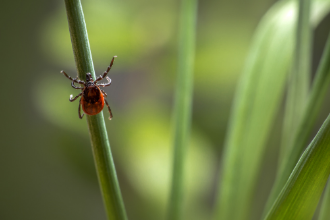Lyme disease is caused by the bacterium Borrelia burgdorferi. Borrelia burgdorferi is a spiral-shaped bacterium. You or your pet can get infected with Lyme disease by the bite of an infected sheep tick (Ixodes ricinus). The sheep ticks become infected when they feed on infected hosts such as rodents, birds and deer. About 20% of all sheep ticks are infected with the Borrelia Burgdorferi bacterium at this moment. Not all bites from infected ticks cause Lyme disease. The longer a tick feeds on a human or pet, the greater the risk of infection is. In particular, the risk of infection increases tremendous after 24 hours.
Lyme disease symptoms in humans and pets
Lyme disease is the fastest growing infectious disease worldwide and the number of patients is still increasing. After infection, the best known symptom in humans is "erythema migrans". This is a red, ring-shaped rash around the site of a tick bite. Please note that a patient can also been infected with the Borrelia burfdorferi bacterium without the development of erythema migrans. If the bacteria remains in the body, this often causes flu-like symptoms. Neurological, joint, skin and heart symptoms can also arise in a chronic stage. In dogs and cats with Lyme disease we often see arthritis. Fever, loss of appetite, lethargy, swollen lymph nodes, kidney, heart and neurological problems can also occur.
Treatment and prevention of Lyme disease
The treatment of Lyme disease is not easy, because the bacteria can convert into different forms which do not respond equally to the same antibiotic therapy. That is why it’s better to prevent an infection with the Borrelia burgdorferi bacterium by treating yourself and your pet pre-emptively against ticks.
Tips to reduce the risk of being infected with the Borrelia burgdorferi bacterium as much as possible:
- Wear long pants and shirts with long sleeves to prevent tick bites. In addition, put your pants into your socks, so ticks can’t make contact with your skin.
- Protect yourself and your pet with preventive products against ticks. At Pharmacy4pets you will find effective products for tick prevention in dogs and cats.
- Check yourself and your pet thoroughly for ticks after you’ve been outdoors.
- If you find a tick on yourself or your pet, then remove the tick as soon as possible (at least within 24 hours) using tick tweezers. Note the date of the tick bite and keep an eye on the site of the tick bite.
- Always consult your family doctor or veterinarian if you or your pet develops Lyme disease symptoms after a tick bite.






